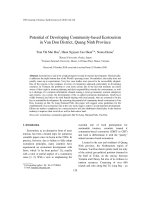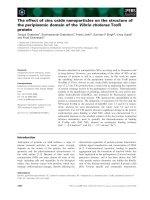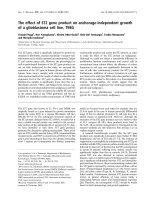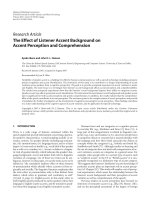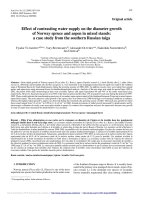The effect of tropical monsoon climate on the karst activity in Cam Lo District–Quang Tri Province
Bạn đang xem bản rút gọn của tài liệu. Xem và tải ngay bản đầy đủ của tài liệu tại đây (44.05 KB, 6 trang )
JOURNAL OF SCIENCE, Hue University, Vol. 69, No. 6, 2011
THE EFFECT OF TROPICAL MONSOON CLIMATE ON THE KARST
ACTIVITY IN CAM LO DISTRICT–QUANG TRI PROVINCE
Nguyen Van Canh, Nguyen Thanh, Tran Thanh Nhan
College of Sciences, Hue University
Abstract. In this paper, first, we would like to mention and analyse main factors which
effect the karst activity in limestone constituting Co Bai Formation (D2-3 cd), and then
quantitatively estimate the alteration in the karstification intensity to this limestone as they
are under the influence of the tropical monsoon climate in Cam Lo region, Quang Tri
province.
Keywords: Karstification, karst activity, Calcium carbonate dissolving product, calcium
carbonate activity product, calcium carbonate saturation deficiency, average coefficient of
calcium carbonate activity.
1
Introduction
Karstification is one of the exogenic natural geodynamic processes that have developed
most widespread in several nations all around the world as well as in Vietnam and Cam
Lo district. Therefore, what is karstification? In our opinion “karstification is the
aggregation of geological processes occurring both in the crust and on the earth surface,
being generated by dissolution (chemical erosion), corrasion (mechanical erosion) of the
surface water and the underground water accompanied by the formation of various
shape- and size-differed spaces in the crust, creation of special movement and behaviour
of ground water as well as specific morphological topography and regional hydrological
system”.
Karst territory may create both positive and negative effects on the environment, the
local life, economy and national security. These are the most sensitive places in terms of
causing many nature and human-induced geohazards. In Cam Lo plain-Quang Tri, karst has
induced vertical land subsidences and indeed occurred frequently in recent days and has
induced the loss of useland, damaged constructions and threatened the local life.
In order to minimize such damage, and re-settle residence area, the local
government of Quang Tri province invested in the project of “Assessment of Karst
activity creating geological environment change in Cam Lo area and proposal of
countermeasures”. We have synthesized the obtained results from this project and
finished this paper.
5
2
Major factors influence the karst activity of limestone making up Co
Bai formation
The real investigation of karst in Cam Lo area showed that in this region, the
karstification process is not only generated by dissolving, corrasing activity of surface
water, ground water but also suffered from local natural and man-made factors’ effects.
However, in terms of this paper, we only mention the major natural factors such as the
existence of dissoluble rocks, tectonic and neotectonic characteristics, dissoluble rocks
with good water-bearing capacity and permeability, consecutive motion of water,
appropriate solvency of water, topographical feature and regional meteorological,
hydrological condition [1].
Within Cam Lo plain area, there is no doubt that carbonate rock with certain
solvency of Co Bai Formation (D2-3 cb) has the largest distribution. Chemical analysing
data on 3 grams of this cacbonate rock gives chemical composition (%) as follows: CaO
= 28.79-52.4%, MgO = 1.03-21.51%, Na2O = 0.01-0.45%, K2O = 0.03-0.59%, Fe2O3 =
0.06-1.32%, Al2O3 = 0.27-4.75%, SiO2 = 0.44-31.48%. This carbonate rock was
generally splitted by faulty systems (Fig. 1), sustained subsequent weathering (factors)
and the karstification process which distributes in the rock’s further fracture, and of
course increases its permeability. The permeability of this carbonate rock fluctuates
from low level (K = 2.32 m/day) to high level (K = 88.06 m/day). Moreover, due to
Hieu River and the affluent system cutting over carbonate rock constituted kame-and
coteau-topography, the previous movement condition of fissured-karst water was very
expedient and water-exchange process took place consecutively; these factors thus
positively distributed more frequent and intensive dissolving and aggressive activities of
water on carbonate rock than those of today. Though there is still insufficient
confirmation of starting and peak time of the karstification process, it seems to be
possible to consider that the stable neotectonic period [4] rolonging between Miocen
and Pliocen (from 5 to 10 million years to present) is the most convenient environment
for karstification development as the area under tropical monsoon climate condition and
as a result, this had planeted mountain masses of limestone into current open-coteau
topography and karst paleoplain. Many underground caves with at 2-3m of size and
with 35-50m of distribition depth were perhaps created during this stable tectonic
duration. However, because of blocky differential subsidence operation in PliocenQuantenary time and depositing and infilling processes related Flandrian transgression
of Cam Lo paleoplain, the initially essential conditions of karst development can no
longer be in advantage and therefore, current karstification’s intensity is much weaker
than that that used to be in Miocen-Pliocen period.
6
3
Quantitative assessment of alteration in karstification intensity under
the effect of tropical monsoon climate condition
In order to clarify whether the karstification operation in Cam Lo plain has been either
stopped or still in process and to determine the fluctuation of karstification intensity
between dry and rainy season, we applied the comparison method using calcium
carbonate dissolving product with calcium carbonate activity product (KCaCO3 = 9.9 109
) and calculation method using calcium carbonate saturation deficiency [1] with input
data obtained from chemical analysis of several fissured-karst water samples (Table 1).
Table 1. Physical property, chemical composition of fissured-karst water.
Dry season
(July, August, 2008)
Composition
mg/l
Rainy season
(October, 2008)
Me/l
Composition
pH = 6.98
3.1
mg/l
me/l
pH = 6.80
Na+ + K+
19.10
0.83
Na+ + K+
4.82
0.20
Ca++
68.14
3.41
Ca++
8.15
0.41
Mg++
14.49
1.19
Mg++
1.07
0.09
Fe+++
0.002
0.0001
Fe+++
-
-
Cl-
24.85
0.70
Cl-
6.07
0.17
NO3-
0.05
0.0008
NO3-
-
-
SO4- -
15.50
0.32
SO4- -
5.76
0.12
HCO3-
270.28
4.43
HCO3-
18.99
0.31
Quantitative assessment of karst activity in dry season
- The comparison method using calcium carbonate dissolving product with calcium
carbonate activity product.
Firstly, it is necessary to determine calcium carbonate activity product (aCa++. a
CO3--) via the calculation of element parameters including ionic force M , ionic activity
coefficient f , content of CO3-- and average coefficient of calcium carbonate activity
yCaCO3 .
+ Ionic force M. Ionic force is determined by the following formula:
1
M 10 3 x1 z1 x2 z 2 x3 z3 xnzn
2
7
(1)
Where
[xi], zi-ionic content and valence respectively.
By substituting the data in Table 1 into equation (1), the result of M = 0.0079 is
obtained.
+ Determination of f value. With M = 0.0079, search from specialty table we
will receive the value of f = 0.54.
+ Determination of CO3-- content. The content of [CO3--] is calculated by the
following equation:
CO3
3.77 x 10 11 HCO3
.f
10 pH
(2)
By substitution of the data in Table 1 into equation (2), we receive CO3 =
0.00077me/l.
+ Determination of yCaCO3 . The value of yCaCO3 is determined via equation as
follows:
log yCaCO3
(3)
1.98 M
1 1.62 M
Substitution of M value into (3) we will receive the value of yCaCO3 = 0.7033.
And activity product aCa++ . a CO3-- can be determined by the following formular:
1
aCa . aCO 10 6 yCaCO3 . Ca . CO3
3
4
(4)
The substitution of the necessary data into (4), the result of calcium carbonate
activity product will be of 0.462x10-9.
+ Comparison between calcium carbonate activity product and dissolve product.
It is evident that activity product aCa++ . a CO3-- = 0.462x10-9 is lower than dissolve
product K CaCO3 = 9.9x10-9, and therefore karst activity still happens and so karst still
develop during dry season.
- The calcium carbonate saturation deficiency.
As already known, saturation deficiency amount xdCa , xdCO can be determined
3
by solving the following basic function:
yCaCO3 Ca xd CO3 xd 0.038
(5a)
By substituting the obtained data into this function and solving it, we will
determine the calcium carbonate saturation deficiency in dry season of xd = 0.15 me/l
(>0). From this positive and very small value of calcium carbonate saturation
deficiency, it is clear that during dry season, karst still on process but with less
intensity.
8
3.2
Quantitative assessment of karst operation in rainy season
- The comparison method between calcium carbonate dissolving product and
calcium carbonate activity product:
By taking the same calculating route and equations as in 2.1 and the chemical
analysed data of fissured-karst water in rainy season (Table 1), we will obtain the
necessary results as follows: M = 0.0096, f = 0.52, CO3 = 0.00004me/l, yCaCO3 =
0.6801, and finally the corresponding result of activity product of aCa++ . a
2.79x10-12 will be determined.
CO3--
=
This result of aCa++ . a CO3-- = 2.79x10-12 is at remarkable lower than the calcium
carbonate dissolving product of K CaCO3 = 9.9x10-9, and also indicates that in rainy
season, karst operation occurs with righ stronger intensity than that in dry season.
- The calcium carbonate saturation deficiency:
The amount of calcium carbonate saturation deficiency in rainy season can be
calculated by an equation as follows:
0.68010.41 xr 0.00004 xr 0.038
(5b)
By substituting the above obtained data and solving function (5b), the solution
of xr = 0.1078me/l (>0) will be acquired for the calcium carbonate saturation
deficiency in fissured-karst water in rainy season.
3.3
Evaluation of the trend of and reason for the variation in karst acitivity
intensity in limestone corresponding with climate season
From the above quantitative assessment of karst activity under climate season effect using
the comparison method between calcium carbonate activity product and dissolving
product as well as calcium carbonate saturation deficiency method, we may define the
alteration in increasing trend of karst activity intensity from dry season to rainy one.
Indeed, the comparison of fissured-karst water’s calcium carbonate activity product
between both seasons demonstrates that activity product of fissured-karst water in rainy
season (2.79x10-12) is sixty times smaller than that in dry season (4.62x10-10), meanwhile
fissured-karst water in the former season is seven times as much in the calcium carbonate
saturation deficiency ( xr = 0.1078 me/l) as in the latter ( xd = 0.1078 me/l).
The reality of less intensive karstification in dry season is undeniably related to
the disadvantageous environment for karst development during this time comparing
with that in rainy season. In which, limited rainfall is considered the essential factor
reducing the amount of water supply for fissured-karst water, restricting water
movement and exchange condition, especially water dissolving ability as its total
mineralization increases.
9
4
Conclusion
From the above mentions, it is possible to propose following conclusions:
- Over the previous geological evolution history, particularly the stable period of
neotectonics in Miocen-Pliocen, the advantageous condition of karst development had
intensified karst activity with the formation of considerable cave numbers at 2-3m of
size distributing at 30-50m of depth over the research area.
- Blocky differential subsidence and depositing, infilling processes related to
Quaternary transgression in Cam Lo graben-shaped valley were the major contributions
to the change in karst developing environment, from previous advantage to current
disadvantage.
- Tropical monsoon climate determinant factors regulated and controlled
seasonal karstification intensity. In which, the larger rainfall, more expedient
movement-exchange condition and better dissolving possibility of water consequently
results in the more powerful karstification operation in rainy season.
References
1. Lomtadze V.D., Engineering geodynamics, Nedra (in Russian), 1977.
2. Popov I.V., Engineering geology, MGU (in Russian), 1959.
3. Socolov D.S., Essential conditions of karst development, Bull. MOIP, Division Geol.,
v.126, N02, 1951.
4. Yem, T.N., On the circumstance of neotectonics in Souther Central Vietnam, Geology.,
v.202-203 (in Vietnamses with abstract), 1991.
10

